Projection-specific Activity of Layer 2/3 Neurons Imaged in Mouse Primary Somatosensory Barrel Cortex During a Whisker Detection Task
- PMID: 35330741
- PMCID: PMC8788860
- DOI: 10.1093/function/zqaa008
Projection-specific Activity of Layer 2/3 Neurons Imaged in Mouse Primary Somatosensory Barrel Cortex During a Whisker Detection Task
Erratum in
-
Corrigendum to: Projection-specific Activity of Layer 2/3 Neurons Imaged in Mouse Primary Somatosensory Barrel Cortex During a Whisker Detection Task.Function (Oxf). 2020 Oct 6;1(2):zqaa020. doi: 10.1093/function/zqaa020. eCollection 2020. Function (Oxf). 2020. PMID: 35333036 Free PMC article.
Abstract
The brain processes sensory information in a context- and learning-dependent manner for adaptive behavior. Through reward-based learning, relevant sensory stimuli can become linked to execution of specific actions associated with positive outcomes. The neuronal circuits involved in such goal-directed sensory-to-motor transformations remain to be precisely determined. Studying simple learned sensorimotor transformations in head-restrained mice offers the opportunity for detailed measurements of cellular activity during task performance. Here, we trained mice to lick a reward spout in response to a whisker deflection and an auditory tone. Through two-photon calcium imaging of retrogradely labeled neurons, we found that neurons located in primary whisker somatosensory barrel cortex projecting to secondary whisker somatosensory cortex had larger calcium signals than neighboring neurons projecting to primary whisker motor cortex in response to whisker deflection and auditory stimulation, as well as before spontaneous licking. Longitudinal imaging of the same neurons revealed that these projection-specific responses were relatively stable across 3 days. In addition, the activity of neurons projecting to secondary whisker somatosensory cortex was more highly correlated than for neurons projecting to primary whisker motor cortex. The large and correlated activity of neurons projecting to secondary whisker somatosensory cortex might enhance the pathway-specific signaling of important sensory information contributing to task execution. Our data support the hypothesis that communication between primary and secondary somatosensory cortex might be an early critical step in whisker sensory perception. More generally, our data suggest the importance of investigating projection-specific neuronal activity in distinct populations of intermingled excitatory neocortical neurons during task performance.
Keywords: goal-directed behavior; licking; neocortex; projection neurons; sensorimotor transformation; sensory perception; somatosensory cortex; two-photon calcium imaging; whisker sensation.
© The Author(s) 2020. Published by Oxford University Press on behalf of the American Physiological Society 2020.
Figures

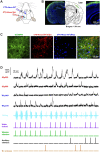
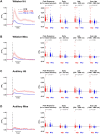
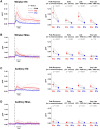
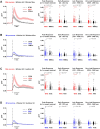
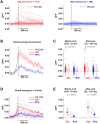



Comment in
-
Pathway-Specific Activation in Sensorimotor Cortical Networks: Perspective on "Projection-Specific Activity of Layer 2/3 Neurons Imaged in Mouse Primary Somatosensory Barrel Cortex During a Whisker Detection Task".Function (Oxf). 2020 Jul 16;1(1):zqaa011. doi: 10.1093/function/zqaa011. eCollection 2020. Function (Oxf). 2020. PMID: 35330740 Free PMC article. No abstract available.
Similar articles
-
Target-specific membrane potential dynamics of neocortical projection neurons during goal-directed behavior.Elife. 2016 Jun 21;5:e15798. doi: 10.7554/eLife.15798. Elife. 2016. PMID: 27328320 Free PMC article.
-
Distinct Contributions of Whisker Sensory Cortex and Tongue-Jaw Motor Cortex in a Goal-Directed Sensorimotor Transformation.Neuron. 2019 Sep 25;103(6):1034-1043.e5. doi: 10.1016/j.neuron.2019.07.008. Epub 2019 Aug 8. Neuron. 2019. PMID: 31402199 Free PMC article.
-
Distributed and specific encoding of sensory, motor, and decision information in the mouse neocortex during goal-directed behavior.Cell Rep. 2024 Jan 23;43(1):113618. doi: 10.1016/j.celrep.2023.113618. Epub 2023 Dec 26. Cell Rep. 2024. PMID: 38150365
-
Cortical circuits for transforming whisker sensation into goal-directed licking.Curr Opin Neurobiol. 2020 Dec;65:38-48. doi: 10.1016/j.conb.2020.08.003. Epub 2020 Oct 13. Curr Opin Neurobiol. 2020. PMID: 33065332 Review.
-
Neocortical dynamics during whisker-based sensory discrimination in head-restrained mice.Neuroscience. 2018 Jan 1;368:57-69. doi: 10.1016/j.neuroscience.2017.09.003. Epub 2017 Sep 14. Neuroscience. 2018. PMID: 28919043 Free PMC article. Review.
Cited by
-
Pathway-Specific Activation in Sensorimotor Cortical Networks: Perspective on "Projection-Specific Activity of Layer 2/3 Neurons Imaged in Mouse Primary Somatosensory Barrel Cortex During a Whisker Detection Task".Function (Oxf). 2020 Jul 16;1(1):zqaa011. doi: 10.1093/function/zqaa011. eCollection 2020. Function (Oxf). 2020. PMID: 35330740 Free PMC article. No abstract available.
-
Toward Biophysical Mechanisms of Neocortical Computation after 50 Years of Barrel Cortex Research.Function (Oxf). 2020 Dec 21;2(1):zqaa046. doi: 10.1093/function/zqaa046. eCollection 2021. Function (Oxf). 2020. PMID: 35330974 Free PMC article. No abstract available.
-
Cell class-specific long-range axonal projections of neurons in mouse whisker-related somatosensory cortices.Elife. 2024 Oct 11;13:RP97602. doi: 10.7554/eLife.97602. Elife. 2024. PMID: 39392390 Free PMC article.
-
Axonal and Dendritic Morphology of Excitatory Neurons in Layer 2/3 Mouse Barrel Cortex Imaged Through Whole-Brain Two-Photon Tomography and Registered to a Digital Brain Atlas.Front Neuroanat. 2022 Jan 25;15:791015. doi: 10.3389/fnana.2021.791015. eCollection 2021. Front Neuroanat. 2022. PMID: 35145380 Free PMC article.
-
VIP interneurons in sensory cortex encode sensory and action signals but not direct reward signals.Curr Biol. 2023 Aug 21;33(16):3398-3408.e7. doi: 10.1016/j.cub.2023.06.086. Epub 2023 Jul 26. Curr Biol. 2023. PMID: 37499665 Free PMC article.
References
Publication types
MeSH terms
LinkOut - more resources
Full Text Sources
